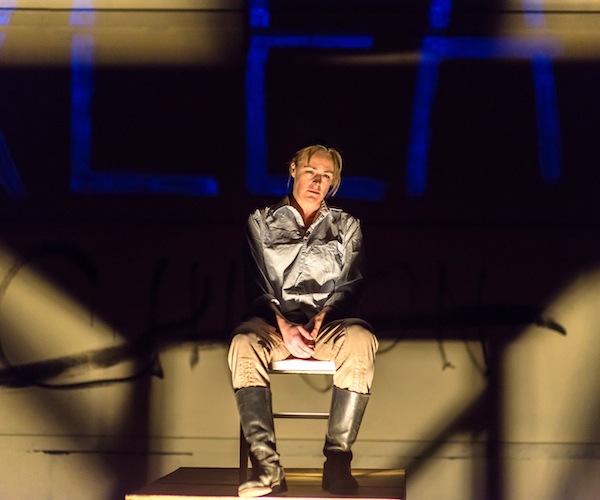Theater Review: Bedlam’s “Saint Joan” — Ferociously Relevant
The virtuoso approach of Bedlam’s Saint Joan, its unpretentious immediacy, makes this production an exuberant Shavian history lesson that should not to be missed.
Bedlam’s Saint Joan, presented by Underground Railway Theater at Central Square Theater, Cambridge, MA through Feb. 8.

Andrus Nichols in “Bedlam’s Saint Joan” at the Central Square Theater in Cambridge. Photo: A.R. Sinclair Photography.
By Terry Byrne
Playwright George Bernard Shaw brilliantly used the three-act play form as an opportunity to educate and provoke his audiences on issues of social justice and political hypocrisy. In 1923, three years after Joan of Arc was canonized a saint by the Catholic Church, Shaw completed his historical drama Saint Joan, which challenged conventional romantic ideas about the 15th-century girl warrior whose heavenly voices helped lead the French to victory over the English.
Bedlam’s Saint Joan follows the standard three-act format: the first act provides the expository set-up – young Joan’s simple but inspiring appeal to a French lord for arms and men – while the second act illuminates her military victories and recounts the threat she poses to the authority of the religious and political elite. The third act sets out her trial as a heretic and then her execution, which is followed by an epilogue, some 25 years later, in which she visits her persecutors, who admit that she was right but are still not ready for her return. Critic Eric Bentley perceptively noted the conflict of irreconcilable positions at the center of the tragedy: “The irresistible force of her genius meets the immoveable object of social order. Shaw is not writing an ‘individualist” defense of Joan; or a ‘collectivist’ defense of the social order. He depicts the clash.”
But even as New York’s Bedlam Theatre Company respects Shaw’s linear approach, they inject an extraordinary ferocity into the give-and-take of his storytelling, due in no small part to the intensity with which the quartet of actors delineate their various characters. At the center is Joan (Andrus Nichols), the 17-year-old farm girl whose earnest insistence on her divine mission makes her irresistible. Nichols is absolutely transparent as Joan, the naïve and even ignorant girl whose unshakable faith leads her to astonishing victory and then to her inevitable downfall. What makes Nichols so compelling as Joan is her ability to communicate the girl’s enthusiasm and her pride in her accomplishments, as well as her frustration, disappointment, and shock at the weakness of the men who first embrace and then callously reject her. During her trial scene, in which she sits in a chair as her accusers shouting questions at her, we witness this girl’s desperation, confusion, and ultimately her resignation to her fate. It’s an impossibly complicated mix of emotions, but Nihcols makes them all perfectly clear.
Although Joan confronts dozens of men – royalty, feudal lords, English generals, common soldiers – Shaw concentrates on the subtleties of the debate rather than on the blows and counterblows of the battles themselves. The Bedlam production allows Joan’s adversaries and allies to come in and out of focus as they serve the discussion, rather than for their own sake. So, the three other actors – Edmund Lewis, Tom O’Keefe and Eric Tucker, who also directs – morph with quicksilver dexterity into nearly 20 other characters. In an enchanting bit of theatrical magic, actors often shift characters in mid-scene, sometimes with two actors sharing one character in a scene as the need arises.

Edmund Lewis, Andrus Nichols, and Eric Tucker in “Bedlam’s Saint Joan” at the Central Square Theater in Cambridge. Photo: A.R. Sinclair Photography.
What is striking is that their characterizations are so detailed that the audience is never in doubt about Joan’s adversary at any given moment. Names are less important than idiosyncratic quirks: Lewis gives the reluctant Dauphin a childish whine while his apoplectic English chaplain de Stogumber nearly explodes with anger at Joan’s success. Tucker is mesmerizing as Warwick, the leader of the English army, who manipulates others in order to eliminate a threat to his political position. Then, just as quickly, he becomes Dunois, Joan’s reluctant military ally. O’Keefe displays the self-righteous piety of a theologian one minute, and then becomes the unnamed English soldier who provided the condemned Joan with a cross to hold.
Bedlam also increases the urgency of Shaw’s talky play by changing the audience’s perspective. The troupe uses two intermissions, as well as a brief pause, to move some spectators around to different positions. The shuffling about is not just a gimmick; it ends up making us more intimate witnesses to the play’s conversations and conclusions. All of this energetic theatricality — the heightened debates, the range of scenes, the appearance of so many characters — is at the service of a simplicity of design that infuses Shaw’s points about nationalism, religion, individuality, gender, and most importantly, power, with a refreshing and compelling vigor.
Bedlam’s Saint Joan cuts to the heart of issues that feel remarkably relevant 500 years after Joan donned her armor. Tucker and company’s virtuoso approach, its unpretentious immediacy, makes this production an exuberant Shavian history lesson that should not to be missed.
Terry Byrne has been writing about the arts for nearly two decades. She has an MFA in Playwriting from Boston University and is a Resident Scholar at Brandeis University’s Women’s Studies Research Center.
Tagged: Bedlam's Saint Joan, Catholic Church, Central Square Theater, George-Bernard-Shaw, Saint Joan, tragedy
